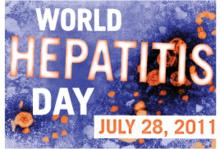Worldwide, an estimated 10 million injecting drug users have hepatitis C virus, while about 1.2 million have hepatitis B virus, based on results from an innovative and comprehensive analysis.
The researchers found wide variation in the geographic prevalence of viral hepatitis among injecting drug users (IDUs), with the highest rates seen in Eastern Europe, East Asia, and Southeast Asia.
"Investment in, and development of, comprehensive and effective strategies to prevent the transmission of viral hepatitis and reduce resultant morbidity and mortality in IDUs are urgently required," wrote Paul K. Nelson, a doctoral candidate at Australia’s National Drug and Alcohol Research Centre, University of New South Wales, Sydney, and his coauthors.
The findings – published online July 28, 2011, in The Lancet to coincide with World Hepatitis Day – suggest that the significance of viral hepatitis "needs to receive greater attention than it does at present," the study authors said (Lancet 2011 July 28 [Epub doi:10.1016/S0140-6736(11)61097-0]).
In what is believed to be the first study of its kind, the researchers reviewed 1,125 peer-reviewed and grey literature sources related to HCV and HBV in IDUs. Infection was defined as presence of HCV antibodies (anti-HCV), hepatitis B core antibodies (anti-HBC), or HBV surface antigen (HBsAg) in studies that included more than 40 participants.
Prevalence data for injecting drug use and HIV infection were obtained from a previously published systematic review by the Reference Group to the United Nations on HIV and Injecting Drug Use, with decision rules and estimates approved by all Reference Group members.
For HCV infection, the researchers located eligible reports with data on prevalence of anti-HCV in IDUs for 77 of the 152 countries or territories where injecting drug use has been reported. These 77 countries make up 82% of the world’s estimated population of IDUs.
Anti-HCV prevalence among IDUs was 60%-80% in 25 counties, including Spain (80%), Norway (76%), Germany (75%), France (74%), the United States (73%), China (67%), and Canada (64%), while the prevalence exceeded 80% in a further 12 countries, including Italy (81%), Portugal (83%), Pakistan (84%), The Netherlands (86%), Thailand (90%), and Mexico (97%).
The lowest prevalence was seen in Australia (55%), New Zealand (53%), and the United Kingdom (50%). Countries with the largest IDU populations infected with HCV were China (1.6 million), the United States (1.5 million), and Russian (1.3 million).
The data showed that worldwide, about 10 million IDUs are anti-HCV positive, which is about 3.5-fold higher than the 2.8 million IDUs who are estimated to be living with HIV.
For hepatitis B, anti-HBC positivity was measured in 43 countries that account for 65% of the world’s estimated population of IDUs. Rates varied widely among countries, from a low of 4.2% in Slovenia to a high of 85% in Mexico. The rate in the United States was 23%.
The prevalence of HBsAg among IDUs was measured in 59 countries accounting for 73% of the world’s estimated population of IDUs. The prevalence ranged from 5% to 10% in 21 counties and exceeded 10% in 10 countries, including the United States (12%). The highest rates were seen in counties that have endemic HBV in the general population, including Vietnam (20%), Estonia (19%), Saudi Arabia (18%), and Taiwan (17%).
For hepatitis B, the researchers estimated that 6.4 million IDUs worldwide are anti-HBC positive, and 1.2 million are HBsAg positive.
"Efforts to prevent, treat, and reduce harms related to liver disease in IDUs are essential – especially in situations in which HIV has successfully been prevented or managed – because the large numbers of IDUs infected with HCV and significant morbidity resulting from this infection mean that the health and economic costs of HCV transmitted by injecting drug use might be as high as (or higher than) those of HIV," the researchers wrote. "Nonetheless, HCV treatment is underused."
One reason for this neglect, they continued, "is the high cost, which will remain a substantial barrier to increasing treatment coverage in low resource settings until costs are reduced."
The researchers recommend bringing viral hepatitis treatments "into the same (lower cost) access framework as HIV antiretrovirals" as well as improving efforts to reduce the effect of other causes of progression of liver disease in people who are chronically infected with viral hepatitis, including addressing "problems of alcohol use, and provision of [hepatitis A virus] and HBV vaccination."


